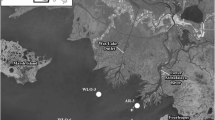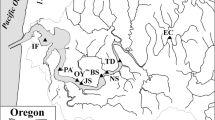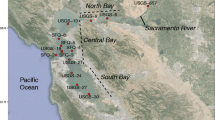Abstract
The in situ rates of oxygen consumption by benthic nitrifiers were estimated at 11 study sites in 4 streams. Two methods were used: an in situ respiration chamber method and a method involving conversion of nitrifying potential measurements to in situ rates. Estimates of benthic nitrogenous oxygen consumption (BNOC) rate ranged from 0–380 mmol of O2 m−2·day−1, and BNOC contributed between 0–85% of the total benthic oxygen consumption rate. The activity of nitrifiers residing in the sediments was influenced by O2 availability, temperature, pH, and substrate. Depending upon site, nitrification could approximate either first-order or zero-order kinetics with respect to ammonium concentration. The source of ammonium for benthic nitrifiers could be either totally from within the sediment or totally from the overlying water. Nitrate produced in the sediments could flux to the water above or be lost within the sediment. The sediments could act as a source (positive flux) or sink (negative flux) for both ammonium (−185 mmol·m−2·day−1 to +195 mmol·m−2·day−1) and nitrate (−135 mmol·m−2·day−1 to +185 mmol·m−2·day−1).
This study provides evidence to suggest that measurements of down-stream mass flow changes in inorganic nitrogen forms may give poor estimates of in situ rates of nitrification in flowing waters.
Similar content being viewed by others
References
Belser LW, Schmidt EL (1978) Diversity in the ammonia-oxidizing nitrifier population of a soil. Appl Environ Microbiol 36:584–588
Berner RA (1980) Early diagenesis. A theoretical approach. Princeton University Press, Princeton, New Jersey, USA
Billen G (1982) An idealized model of nitrogen recycling in marine sediments. Am J Sci 282: 512–541
Blackburn TH, Henriksen K (1983) Nitrogen cycling in different types of sediments from Danish waters. Limnol Oceanogr 28:477–493
Cirello J, Rapaport RA, Strom PF, Matulewich VA, Morris ML, Goetz S, Finstein MS (1979) The question of nitrification in the Passaic River, New Jersey: analysis of historical data and experimental investigation. Water Res 13:525–537
Cooper AB (1983) Population ecology of nitrifiers in a stream receiving geothermal inputs of ammonium. Appl Environ Microbiol 45:1170–1177
Cooper AB (1983) Effect of storm events on benthic nitrifying activity. Appl Environ Microbiol 46:957–960
Curtis EJC, Durrant K, Harman MMI (1975) Nitrification in rivers in the Trent Basin. Water Res 9:255–268
Downes MT (1978) An improved hydrazine reduction method for the automated determination of low nitrate levels in freshwater. Water Res 12:673–675
Fletcher M (1979) The attachment of bacteria to surfaces in aquatic environments. In: Ellwood DC, Melling J, Rutter P (eds) Adhesion of microorganisms to surfaces. Academic Press, New York, pp 87–108
Florek RJ, Rowe GT (1983) Oxygen consumption and dissolved inorganic nutrient production in marine coastal and shelf sediments of the Middle Atlantic Bight. Int Rev Ges Hydrobiol 68:73–112
Focht DD (1979) Microbial kinetics of nitrogen losses in flooded soils. In: Brady NC (ed) Nitrogen and rice. International Rice Research Institute, Los Banos, Phillipines, pp 119–134
Focht DD, Verstraete W (1977) Biochemical ecology of nitrification and denitrification. In: Alexander M (ed) Advances in microbial ecology, vol 1. Plenum Press, New York, pp 135–214
Garland JHN (1973) Nitrification in rivers: studies in the Trent Basin. In: James A (ed) Symposium on the use of mathematical models in water pollution control, vol 2. Department of Civil Engineering, Division of Public Health Engineering, Newcastle upon Tyne, pp 15–54
Hansen JI, Henriksen K, Blackburn TH (1981) Seasonal distribution of nitrifying bacteria and rates of nitrification in coastal marine sediments. Microb Ecol 7:297–304
Henriksen K, Hansen JI, Blackburn TH (1981) Rates of nitrification, distribution of nitrifying bacteria, and nitrate fluxes in different types of sediment from Danish waters. Marine Biol 61:299–304
Hines WG, McKenzie SW, Rickert DA, Rinella FA (1977) Dissolved-oxygen regimen of the Willamette River, Oregon, under conditions of basinwide secondary treatment. U.S. Geological Survey circular 715-1. U.S. Geological Survey, Arlington, Virginia
Kaushik NK, Robinson JB (1976) Preliminary observations on nitrogen transport during summer in a small spring-fed Ontario stream. Hydrobiologia 49:59–63
Klump JV, Martens CS (1981) Biogeochemical cycling in an organic rich coastal marine basin—II. Nutrient sediment-water exchange processes. Geochim Cosmochim Acta 45:101–121
Lopez-Bemal FF, Krenkel PA, Ruane RJ (1977) Nitrification in free-flowing streams. Prog Water Technol 9:821–832
Matulewich VA, Finstein MS (1978) Distribution of autotrophic nitrifying bacteria in a polluted river (the Passaic). Appl Environ Microbiol 35:67–71
Paerl HW (1980) Attachment of microorganisms to living and detrital surfaces in freshwater systems. In: Bitton G, Marshall KC (eds) Adsorption of microorganisms to surfaces. John Wiley and Sons, New York, pp 375–402
Ruane RJ, Krenkel PA (1978) Nitrification and other factors affecting nitrogen in the Holston River. J Water Pollut Control Fed 50:2016–2028
Schmidt EL, Belser LW (1982) Nitrifying bacteria. In: Page AL, Miller RH, Keeney DR (eds) Methods of soil analysis, 2nd ed. American Society for Agronomy, Madison, Wis, pp 1027–1042
Technicon Corp., Inc. (1973) Ammonia in water and seawater. Technicon Industrial Method no. 154-71 W/B. Technicon Corp Inc, Tarrytown, New York
Vanderborght J-P, Wollast R, Billen G (1977) Kinetic models of diagenesis in disturbed sediments. Part 2. Nitrogen diagenesis. Limnol Oceanogr 22:794–803
Vincent WF, Downes MT (1980) Variation in nutrient removal from a stream by watercress (Nasturtium officinale R. Br.) Aquatic Bot 9:221–235
Author information
Authors and Affiliations
Rights and permissions
About this article
Cite this article
Cooper, A.B. Activities of benthic nitrifiers in streams and their role in oxygen consumption. Microb Ecol 10, 317–334 (1984). https://doi.org/10.1007/BF02015557
Issue Date:
DOI: https://doi.org/10.1007/BF02015557




